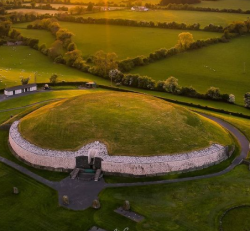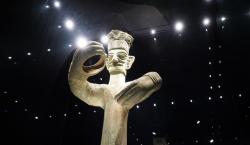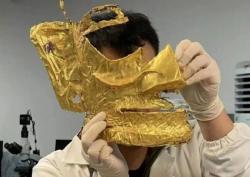INSTITUT SUPERIEUR D'ANTHROPOLOGIE
INSTITUTE OF ANTHROPOLOGY
ONLINE COURSES / COURS A DISTANCE
SPRING TERM : JUNE 2021
REGISTER NOW
INDE –  Boha - Using Google Earth images, drone observations and field visits, two independent researchers from France have identified eight sites around Jaisalmer in the Thar Desert, that show linear features resembling geoglyphs. Geoglyphs are large, un-explained geometrical patterns on land usually proposed to be man-made features. The new paper published in Archaeological Research in Asia notes that the identified geoglyphs in the Thar Desert cover an area of about 6 square km. The authors’ main area of interest was Boha, a small village 40 km to the north of Jaisalmer where they noticed a series of concentric and linear features. The Boha geoglyphs are clearly manmade as the main unit is a giant spiral, but they have been eroded due to the cars running over the lines lately. The French authors also suggest that the lines could be contemporary with the neighbouring memorial stones. During the fieldwork in 2016, the team located a total of nine monoliths with the most imposing one being a truncated conical pillar measuring about 1.60 metres. They also located four memorial stones with sculptures of Hindu deities (Krishna and Ganesha).
Boha - Using Google Earth images, drone observations and field visits, two independent researchers from France have identified eight sites around Jaisalmer in the Thar Desert, that show linear features resembling geoglyphs. Geoglyphs are large, un-explained geometrical patterns on land usually proposed to be man-made features. The new paper published in Archaeological Research in Asia notes that the identified geoglyphs in the Thar Desert cover an area of about 6 square km. The authors’ main area of interest was Boha, a small village 40 km to the north of Jaisalmer where they noticed a series of concentric and linear features. The Boha geoglyphs are clearly manmade as the main unit is a giant spiral, but they have been eroded due to the cars running over the lines lately. The French authors also suggest that the lines could be contemporary with the neighbouring memorial stones. During the fieldwork in 2016, the team located a total of nine monoliths with the most imposing one being a truncated conical pillar measuring about 1.60 metres. They also located four memorial stones with sculptures of Hindu deities (Krishna and Ganesha).
https://www.thehindu.com/sci-tech/science/new-geometrical-lines-discovered-in-thar-desert/article34716927.ece
POLOGNE - Tunel Wielki - Archaeologists reveal findings of a child burial in the Tunel Wielki cave system, in which the skull of a finch was ritually placed in the mouth. The burial was first discovered decades ago in the Kraków-Częstochowa Upland (also known as the Jurassic Highland) of Poland near the village of Ojców. Excavations at the time revealed a shallow grave containing a young girl aged between 10-12 years old in one of the cave’s two chambers, where the skull of a finch was placed in the child’s mouth, along with a second bird skull deposited alongside the remains. After several years of study, archaeologists have determined through a genetic analysis that the girl was not a slav, and likely came with Finnish troops that supported King Carl Gustav’s Swedish invasion of Poland at the beginning of the second half of the 17th century. During this time, Fin-no-Karelian troops of a Swedish garrison was stationed at Ojców Castle which is situated near to the cave. The team tried to find similar funeral rituals in Scandinavia, but failed to find any direct analogies. The researchers pointed out that in some regions of Finland several hundred years ago, Christianity was not so deeply entrenched and practices referring to pagan rituals were not uncommon. Up until the 19th century AD, forest burials were still practiced in regions such as Karelia from the White Sea coast to the Gulf of Finland. The researchers Finnish colleague Dr Kot pointed out that “birds symbolised the soul’s journey after death. However, we do not know of any bird-headed burials from the area of north-eastern Scandinavia” which adds to the mystery.
https://www.heritagedaily.com/2021/06/child-burial-in-cave-had-birds-skull-placed-in-mouth/139369
SOUDAN –  Dongola - Researchers led by Artur Obłuski of the University of Warsaw have found the remains of a large medieval church in the center of Old Dongola, Northern State, Sudan. Dongola was the capital of Makura, one of the Christian Nubian kingdoms, Obłuski explained. He suggests the building could have served as the seat of the archbishop of Dongola, who governed the Nubian churches along a 620-mile stretch of the Nile River. The team members have uncovered the church’s apse, an adjacent wall, and the dome of a large tomb. The apse, Obłuski added, is the largest yet found in Nubia, and it was decorated with plaster and paintings of monumental figures. Much of its walls remain buried. It had been previously thought that the city’s medieval cathedral was situated outside the city walls, but this structure resembles the cathedral unearthed in the center of Faras, the medieval capital of the Nubian kingdom of Nobadia. “There may be more paintings and inscriptions under our feet, just like in Faras,” Obłuski said. To read about a fourth-century A.D.
Dongola - Researchers led by Artur Obłuski of the University of Warsaw have found the remains of a large medieval church in the center of Old Dongola, Northern State, Sudan. Dongola was the capital of Makura, one of the Christian Nubian kingdoms, Obłuski explained. He suggests the building could have served as the seat of the archbishop of Dongola, who governed the Nubian churches along a 620-mile stretch of the Nile River. The team members have uncovered the church’s apse, an adjacent wall, and the dome of a large tomb. The apse, Obłuski added, is the largest yet found in Nubia, and it was decorated with plaster and paintings of monumental figures. Much of its walls remain buried. It had been previously thought that the city’s medieval cathedral was situated outside the city walls, but this structure resembles the cathedral unearthed in the center of Faras, the medieval capital of the Nubian kingdom of Nobadia. “There may be more paintings and inscriptions under our feet, just like in Faras,” Obłuski said. To read about a fourth-century A.D.
https://scienceinpoland.pap.pl/en/news/news%2C87989%2Cnewly-discovered-church-dongola-could-have-been-cathedral-say-archaeologists.html
FRANCE –  Chelles - Les archéologues de l’Institut national de recherches archéologiques préventives (Inrap) font une fouille sur un terrain avant un chantier du Grand Paris Express, rue Gustave Nast à Chelles, entre mai et juin 2021. Depuis le 3 mai, ils ont déjà trouvé des milliers d’objets anciens, très petits pour beaucoup mais pas tous : des os de cheval ont notamment été découverts. « Des hommes ou femmes ont laissé intentionnellement de la chair aux articulations entre les os pour qu’ils restent attachés les uns aux autres », explique Audrey Bellido, responsable du chantier archéologique. Comment expliquer cet acte de nos ancêtres ? Les scientifiques y réfléchiront dans un second temps. Des morceaux de silex ont aussi été trouvés sur le terrain. Audrey Bellido explique qu’ils ont été taillés de façon rudimentaire. Les savants ont découvert sur ce terrain des traces de plusieurs époques remontant jusqu’au Mésolithique, il y a 10 000 ans. Dans le même quartier, un port gaulois conservé en sous-sol dans des conditions extrêmement rares avait été découvert entre 2006 et 2007. À l’époque, la Marne comportait plusieurs bras qui coulaient entre des dunes de sable. Au Ier siècle après Jésus-Christ, le chenal s’est envasé et le port a cessé de servir.
Chelles - Les archéologues de l’Institut national de recherches archéologiques préventives (Inrap) font une fouille sur un terrain avant un chantier du Grand Paris Express, rue Gustave Nast à Chelles, entre mai et juin 2021. Depuis le 3 mai, ils ont déjà trouvé des milliers d’objets anciens, très petits pour beaucoup mais pas tous : des os de cheval ont notamment été découverts. « Des hommes ou femmes ont laissé intentionnellement de la chair aux articulations entre les os pour qu’ils restent attachés les uns aux autres », explique Audrey Bellido, responsable du chantier archéologique. Comment expliquer cet acte de nos ancêtres ? Les scientifiques y réfléchiront dans un second temps. Des morceaux de silex ont aussi été trouvés sur le terrain. Audrey Bellido explique qu’ils ont été taillés de façon rudimentaire. Les savants ont découvert sur ce terrain des traces de plusieurs époques remontant jusqu’au Mésolithique, il y a 10 000 ans. Dans le même quartier, un port gaulois conservé en sous-sol dans des conditions extrêmement rares avait été découvert entre 2006 et 2007. À l’époque, la Marne comportait plusieurs bras qui coulaient entre des dunes de sable. Au Ier siècle après Jésus-Christ, le chenal s’est envasé et le port a cessé de servir.
https://actu.fr/ile-de-france/chelles_77108/archeologie-a-chelles-des-objets-prehistoriques-decouverts-rue-gustave-nast_42334822.html
ARABIE SAOUDITE – Tayma - Excavation project at the site of King Ramses III, one of the kings of the 20th Dynasty of ancient Egypt, in Saudi Arabia in November. King Ramses III had deployed several missions to extract copper from a neighboring country and recorded this on a papyrus from that era. On Nov. 7, 2010, the Saudi Supreme Commission for Tourism and Antiquities (SCTA) announced the discovery of what it described as the first hieroglyphic inscription in the Arabian Peninsula dating back to the 12th century B.C., an inscription found on a rock in the Tayma region of northern Saudi Arabia. The inscription includes a cartouche of King Ramses III, who ruled Egypt between 1192 and 1160 B.C., which confirms the existence of a commercial relationship between the two countries at that time. More cartouches of Ramses III to be found on the trade route, or cartouches of other kings of Egypt in Hasma — a sand desert in the Tabuk region of northern Saudi Arabia, stretching over 400 kilometers (248 miles) between Tayma and the Aqaba Gulf on the Red Sea. The area is characterized by rocky facades suitable for writing and engraving.
https://www.al-monitor.com/originals/2021/06/egypt-traces-relics-ramses-iii-back-saudi-arabia
IRLANDE –  Newgrange - Scientists estimate that it was built approximately 3,200 BC. Scientists say Ireland's "mega tomb" may surpass even the iconic stone circle monument. Little is known about who built it, while the purpose of the grave still remains a mystery, with researchers assuming it was built for ritual gatherings and served as a place where people honoured their ancestors. One thing all scientists agree on is that Newgrange is a feat of engineering. The monument is aligned with the winter solstice – the longest night and shortest day of the year. When a ray of sunshine enters the tomb it lights up the 18-metre corridor that leads to the burial chambers. Archaeologists are baffled at how the builders managed to construct such a complex monument, given that they only had rudimentary technology. The burial chambers contain the ashes and bones of four of five people. Who they are is a mystery, too. Scientists assume that only high-profile individuals such as priests or rulers were buried in Newgrange. The facade of the monument, which is approximately five centuries older than the Giza Pyramids and Stonehenge, is made of white quartz. The interior of the monument is decorated with stone carvings.
Newgrange - Scientists estimate that it was built approximately 3,200 BC. Scientists say Ireland's "mega tomb" may surpass even the iconic stone circle monument. Little is known about who built it, while the purpose of the grave still remains a mystery, with researchers assuming it was built for ritual gatherings and served as a place where people honoured their ancestors. One thing all scientists agree on is that Newgrange is a feat of engineering. The monument is aligned with the winter solstice – the longest night and shortest day of the year. When a ray of sunshine enters the tomb it lights up the 18-metre corridor that leads to the burial chambers. Archaeologists are baffled at how the builders managed to construct such a complex monument, given that they only had rudimentary technology. The burial chambers contain the ashes and bones of four of five people. Who they are is a mystery, too. Scientists assume that only high-profile individuals such as priests or rulers were buried in Newgrange. The facade of the monument, which is approximately five centuries older than the Giza Pyramids and Stonehenge, is made of white quartz. The interior of the monument is decorated with stone carvings.
https://sputniknews.com/science/202106061083084434-scientists-still-struggle-to-solve-mysteries-of-irelands-mega-tomb-monument/
CHINE – 
 Sanxingdui - The two pits believed to be from a mysterious culture that inhabited the area around 1200-1000 BC. The pits are thought to be a sacrificial burial ground, but nobody has confirmed this theory. Were the human-shaped bronze statues, with their protruding eyes and large ears, used during a sacrificial ritual to worship gods? Why were these artefacts battered and burned but then buried in an orderly manner in layers inside the pits? The answers to these questions could be found if the archaeologists could find ancient writing that might provide insights into ancient civilisation’s culture. But, so far, no such text has been discovered. Lei, now a researcher with Sichuan Provincial Institute of Cultural Relics and Archaeology, is hopeful a new excavation project in the Sanxingdui Ruins might help find text with the help of technology. “If text is discovered in Sanxingdui, it would be found on organic carriers such as fabrics, lacquerware or woodworkings. Because these people could create advanced and developed bronze, there must be text in such a high level of civilisation. We need to find it,” he said. With a high-resolution scanning electron microscope, archaeologists have identified and excavated traces of fabrics in the soil and on the surface of bronze in six newly discovered pits, even though the material is not visible to the naked eye. The ruins are from an ancient kingdom called Gushu, which did not exist in the historical records, only in legend or ancient poems. Back then, the archaeologists moved quickly and removed about 1,700 pieces of ivory, bronze, pottery within two months. The speed of the excavation left many details of the surrounding environment missing. The latest remarkable discoveries at Sanxingdui – such as a 3,000-year-old, 1.15-metre-tall bronze figure holding an ancient wine vessel revealed in May – are thanks to efforts from Lei and his team to re-examine an area that had been deemed thoroughly scavenged.
Sanxingdui - The two pits believed to be from a mysterious culture that inhabited the area around 1200-1000 BC. The pits are thought to be a sacrificial burial ground, but nobody has confirmed this theory. Were the human-shaped bronze statues, with their protruding eyes and large ears, used during a sacrificial ritual to worship gods? Why were these artefacts battered and burned but then buried in an orderly manner in layers inside the pits? The answers to these questions could be found if the archaeologists could find ancient writing that might provide insights into ancient civilisation’s culture. But, so far, no such text has been discovered. Lei, now a researcher with Sichuan Provincial Institute of Cultural Relics and Archaeology, is hopeful a new excavation project in the Sanxingdui Ruins might help find text with the help of technology. “If text is discovered in Sanxingdui, it would be found on organic carriers such as fabrics, lacquerware or woodworkings. Because these people could create advanced and developed bronze, there must be text in such a high level of civilisation. We need to find it,” he said. With a high-resolution scanning electron microscope, archaeologists have identified and excavated traces of fabrics in the soil and on the surface of bronze in six newly discovered pits, even though the material is not visible to the naked eye. The ruins are from an ancient kingdom called Gushu, which did not exist in the historical records, only in legend or ancient poems. Back then, the archaeologists moved quickly and removed about 1,700 pieces of ivory, bronze, pottery within two months. The speed of the excavation left many details of the surrounding environment missing. The latest remarkable discoveries at Sanxingdui – such as a 3,000-year-old, 1.15-metre-tall bronze figure holding an ancient wine vessel revealed in May – are thanks to efforts from Lei and his team to re-examine an area that had been deemed thoroughly scavenged.
VIDEO =https://www.youtube.com/watch?v=TJknwAL8Dsw
https://www.asiaone.com/china/people-think-remarkable-discoveries-are-aliens-chinese-archaeologists-hope-they-reveal